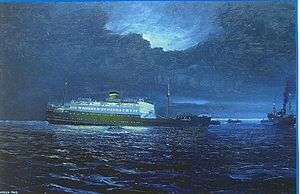MV Munster (1937)
MV Munster was a passenger ferry operated by the British and Irish Steam Packet Company from 1938 to 1940. She was sunk by a mine during WWII.
 Munster mined approaching Liverpool | |
| History | |
|---|---|
| Name: | MV Munster (1937-40) |
| Namesake: | Munster |
| Owner: | British and Irish Steam Packet Company |
| Port of registry: | Liverpool |
| Route: | Liverpool-Dublin (1938-1940) |
| Builder: | Harland and Wolff |
| Yard number: | 996 |
| Launched: | 3 November 1937 |
| Completed: | 22 February 1938 |
| Identification: | Official No.166226 |
| Fate: | sank in 1940 |
| General characteristics | |
| Tonnage: | 4,302 GT |
| Length: | 345 ft (105.2 m) |
| Beam: | 50 ft (15.2 m) |
| Draught: | 4.13 m (13.5 ft) |
| Installed power: | 2 x Single Acting (S.A.) Diesel 1347 n.h.p. |
| Propulsion: | Twin screws |
| Speed: | 17 knots (31 km/h; 20 mph) |
| Notes: | [1] |
History
MV Munster was a passenger ship built by Harland and Wolff for the British and Irish Steam Packet Company in 1937.[2] She and her sister MV Leinster took up their intended service between Liverpool and Dublin in 1938. Their original buff hulls were later changed to dark green.[2] Although they were the largest vessels in the Coast Lines fleet, they did not have capacity for cattle on the Dublin route. Two cattle carriers were added to the fleet: Kilkenny (1,320 tons from the Liffey Dockyard), and Dundalk (630 tons from Ardrossan, Scotland).[3][4]
Whilst on the Belfast to Liverpool run on 2 February 1940, Munster triggered a magnetic mine near the Liverpool Bar at 6 am, laid by German submarine U-30. Munster sank; all 250 aboard were rescued, although one died later.[1]
Service
References
- "Munster". The Yard/Harland & Wolff. Retrieved 19 August 2018.
- "1938 Munster (3) (British and Irish)". Ian Boyle/Simplon Postcards. Retrieved 19 August 2018.
- "B&I Line". Irish Ferries Enthusiasts. Retrieved 19 August 2018.
- Ian Collard (2015). Coast Lines: Fleet List and History. Amberley Publishing Limited. ISBN 1445646757. Retrieved 19 August 2018.